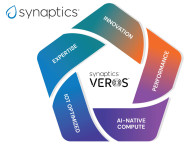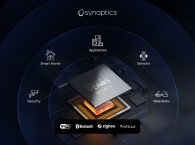Across industries, energy harvesting can cut energy costs, eliminate the need for batteries – and reduce the environmental impact of battery waste. The xG22E wireless SoC family is designed to operate within these tight power constraints and expand the reach of connected devices, using only the ambient energy from its environment.
As a leading vendor in intelligent wireless technology, Silicon Labs' new SoC family will enable manufacturers and developers to build high-performance, Bluetooth Low Energy (LE), 802.15.4-based, proprietary 2.4GHz, or Sub-GHz wireless devices for battery-optimized and battery-free devices that can harvest energy from external sources in their environments like indoor or outdoor ambient light, ambient radio waves, and kinetic motion.
To help device manufacturers build a complete energy harvesting solution, Silicon Labs is also announcing their partnership with e-peas, a provider of Power Managed Integrated Circuits (PMICs) designed for energy harvesting. Through this partnership, Silicon Labs and e-peas co-developed two energy harvesting shields for Silicon Labs' new, energy-optimized xG22E Explorer Kit. To better develop within the tight constraints that energy harvesting requires, the new xG22E Explorer Kit allows developers to customize the peripherals and debugging options that best match their application and get highly accurate measurements to better build their applications and devices with the energy harvesting shields.
The energy harvesting shields are each tuned and optimized for different energy sources and energy storage technologies. They are custom-fit to slot onto the Explorer Kit. Notably, one of the shields uses e-peas' latest AEM13920 dual-harvester, which allows it to pull energy simultaneously from two distinct energy sources, like indoor or outdoor light, thermal gradients, and electromagnetic waves without sacrificing on energy conversion efficiency. The second co-developed shield is based on e-peas' AEM00300 shield, and is dedicated to harvesting power from random pulsed energy sources.
"As the market for energy harvesting and low-power solutions grows, Silicon Labs remains dedicated to enhancing our wireless MCU and radio stack capabilities to advance the development of battery-free IoT solutions," says Ross Sabolcik, Senior Vice President for the Industrial and Commercial Business Unit at Silicon Labs. "Our efforts to prioritize energy efficiency and increase device longevity underscore our commitment to fostering a more sustainable IoT ecosystem."
The evolution and widespread deployment of connected wireless devices is the target for this initiative that Silicon Labs calls Ambient IoT. Traditional sources like mains power or batteries pose scalability and maintenance issues. Ambient IoT addresses this challenge by introducing a class of connected devices primarily powered through energy harvesting from ambient sources like radio waves, light, motion, and heat.
The xG22E family comes equipped with several features designed to minimize energy use and make it the platform of choice for energy harvesting, including ultra-fast, low-energy cold start for applications starting from a zero-energy state to transmit packets and then rapidly return to sleep. An xG22E device wakes up in only eight milliseconds and uses only 150 micro-Joules, or roughly 0.003% of the energy needed to power a 60-watt equivalent LED lightbulb for one second.
Energy conserving deep sleep swift wake-up reduces wake-up energy by 78% compared to other Silicon Labs devices. Power-efficient energy mode transition to smoothly transition in and out of energy modes by mitigating current spikes or inrush, which can harm energy storage capacity. And multiple deep sleep wake-up options, such as RFSense, GPIO, and RTC wake-up sources from the deepest EM4 sleep mode, are ideal for extended storage.
Silicon Labs is determined to actively support companies developing low-power devices and pursuing battery-free designs, fostering an environmentally sustainable leadership within their respective fields. The company will promote a webinar on May 9, 2024, to promote this initiative. The registration page is available here.
www.e-peas.com
www.silabs.com






